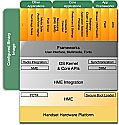Linux phone stack to debut at LinuxWorld
Aug 7, 2006 — by LinuxDevices Staff — from the LinuxDevices Archive — views [Updated 12:30] — Startup a la Mobile says its Linux-based mobile phone stack is available now for customer evaluation. The “Convergent Linux Platform” (CLP) is touted as the “first complete and configurable OS for mobile phones.” It will be demonstrated at the LinuxWorld Expo next week in San Francisco.
[Updated 12:30] — Startup a la Mobile says its Linux-based mobile phone stack is available now for customer evaluation. The “Convergent Linux Platform” (CLP) is touted as the “first complete and configurable OS for mobile phones.” It will be demonstrated at the LinuxWorld Expo next week in San Francisco.
(Click for larger view of Convergent Linux Platform architecture)
A la Mobile announced its “Convergent Linux Platform” (CLP) in June. The stack has a unique architecture featuring a “Hardware Mobility Engine” (HME). The HME appears to be a proprietary driver and hardware emulation layer that the company likens to a “BIOS for mobile phones.” According to a la Mobile, it allows “a single software stack in binary form to move across different handsets — even those based on processors from different manufacturers — without tedious and costly porting or modifications.”
Other touted advantages of CLP include:
- An “open nature” lets users choose software components, functionality, and device look and feel
- The “full and complete” stack includes device drivers, Linux kernel, and middleware
- Stack is fully “integrated, tested, certified, supported, and maintained”
A la Mobile also touts CLP as an antidote to the “fragmentation” currently plaguing Linux in the mobile phone market, where radical implementation differences mean that third-party software supporting one vendor's Linux phone may not run on another's. A la Mobile CEO Pauline Lo Alker said, “There's no one magic pill [for fragmentation], but we're doing our part to minimize it, and enforce interoperability. If you are going to be building platforms using HME, you know you will have binary compatibility.”
Additionally, Lo Acker said a la Mobile plans to fight fragmentation by working with the non-profit Linux mobile phone Foundation recently announced by six large handset vendors and carriers. And, a la Mobile has already joined the OSDL, in order to contribute to the Mobile Linux Initiative, another group aiming to reduce Linux fragmentation at the kernel level.
Lo Acker adds, “Utopia would be if semiconductor vendors could build HMEs into the chip.”
Stacey Quandt, IT analyst with Quandt Analytics, stated, “As an open, non-proprietary operating system, Linux provides flexibility, freedom of choice, and a cost advantage that makes it compelling as a viable alternative to Windows Mobile, Symbian and other proprietary offerings. A solution like a la Mobile's takes this advantage a step further by building in functionality that allows handset manufacturers to minimize the application platform fragmentation issues that have plagued the industry for years.”
Availability
A la Mobile's CLP is available now for customer evaluation, the company says. The first available HME support is for Intel's PXA270 and PXA255 chips. Support is planned next for Texas Instruments's OMAP-based mobile applications processors. The technology should support any ARM9-based processors, according to the company.
PalmSource also plans to demonstrate its Linux stack for mobile phones at LinuxWorld, during a Palmsource Developer Day featuring several hands-on sessions for engineers.
This article was originally published on LinuxDevices.com and has been donated to the open source community by QuinStreet Inc. Please visit LinuxToday.com for up-to-date news and articles about Linux and open source.